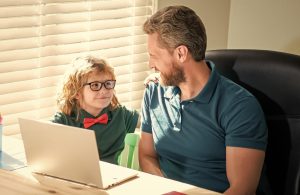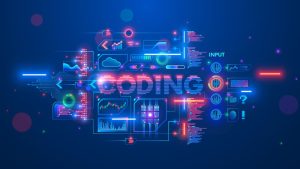As the world becomes increasingly digital, programming is no longer a skill reserved only for professionals. Today, it’s regarded as an essential language of the future, shaping and defining our tech-driven era. Many educators and parents now believe that introducing kids to coding is akin to equipping them with a new-age superpower. But when should one embark on this journey? And with what languages? Let’s dive in!

When to Start Teaching Kids to Code?
The age-old adage, “The early bird gets the worm,” holds truth even in the realm of coding. Children’s brains are malleable, curious, and incredibly adaptable, especially in their formative years. This sponge-like absorption capacity makes younger ages ideal for introducing new concepts.
Introducing kids to basic coding principles as early as preschool doesn’t mean they’ll be hammering away at a keyboard writing complex programs. At this stage, it’s about exposure and understanding. Tools like visual platforms and coding games help kids grasp foundational concepts like sequencing, loops, and conditionals, often without them even realizing they’re learning the basics of programming. Moreover, starting early gives children the flexibility to explore, make mistakes, learn, and eventually, find their unique coding style.
Read More
Best Programming Languages for Kids
When choosing a programming language for children, it is important to carefully consider several key factors. One of the most important considerations is the child’s age, as different languages may be more or less appropriate depending on the child’s developmental stage. Additionally, the child’s interests and prior experience with coding should also be taken into account, as these factors can greatly impact their engagement and motivation to learn.
It is also important to consider the level of challenge presented by the language, as this can help ensure that the child remains engaged and interested in the learning process. There are many excellent programming languages available for children, each with its own unique strengths and weaknesses. Some languages may be better suited for complete beginners, while others may be more appropriate for more advanced learners.
Ultimately, the goal is to select a language that will provide the child with a solid foundation of coding skills that will serve them well as they continue to grow and learn. By carefully considering these key factors, parents and educators can help ensure that children are able to develop the skills and knowledge they need to succeed in an increasingly digital world.
Scratch
Scratch, a visual programming platform, is often the first introduction to programming for children aged 6-10. This project originated from the MIT Media Lab, and it allows children to create stories, animations, and games by dragging and dropping colourful blocks on a jigsaw-like interface instead of traditional code. This hands-on approach helps children grasp the fundamentals of computational thinking and problem-solving without overwhelming them with complex syntax.
Python
As kids transition from visual to text-based coding around the age of 10 or older, Python is a beacon. Its straightforward syntax reads like English, making it easier for kids to understand and write code. Python also offers a versatile playground – from web and game development to AI projects. With platforms like Codiska offering Python courses, kids can comfortably navigate this language’s nuances.
JavaScript
The backbone of web interactivity, JavaScript, is perfect for older kids drawn to web development. They can craft interactive websites and even web-based games. Its ubiquity ensures that skills acquired aren’t just academic but have practical applications in real-world scenarios.

Lua (with Roblox Studio)
Roblox isn’t just a gaming platform; it’s also a learning avenue. Kids fascinated with game development can harness Lua to design and even monetize their unique games on Roblox.
Blocky
Another brainchild of Google, Blockly bridges the gap between visual and text-based coding. Its drag-and-drop interface can be translated to several languages, including Python and JavaScript. This dual perspective allows kids to transition smoothly to text-based programming.
Before starting, Set Up an Environment Conducive to Learning!
Imagine trying to solve a puzzle in the midst of chaos. Difficult, isn’t it? Similarly, when diving into coding, the environment plays a significant role in a child’s learning trajectory. Setting up a dedicated coding space means creating a sanctuary free from distractions, where creativity and logical thinking can thrive.
Here are some steps to create the perfect coding space:
- Quiet and Comfortable: The space should be free from unnecessary distractions like TV sounds or frequent foot traffic.
- Well-Lit: Good lighting reduces eye strain, especially when kids are working on screens.
- Organized Desk Space: Having all materials—books, computers, tablets—in one organized space means fewer interruptions and a smoother learning experience.
- Tech Ready: Ensure a strong and stable internet connection, essential for online courses or accessing coding platforms.
- Inspiration at Arm’s Length: Consider having a wall or board where they can pin up coding tips, ideas, or anything that inspires them.
The Necessity of Learning Programming by Children
We live in a digital age, where algorithms decide everything from our playlist recommendations to financial trends. As this digital wave continues to swell, understanding the language behind it becomes imperative. For children, coding isn’t just about creating games or software; it’s about understanding the digital world they inhabit.
Coding hones skills beyond just computer proficiency:
- Problem-Solving: While coding, kids often encounter bugs or unexpected outcomes. Fixing these instills resilience and teaches them to approach problems methodically.
- Creativity: Coding is as much about creativity as logic. It’s about designing unique solutions, inventing new games, or even animating stories.
- Mathematical Foundations: Through coding, abstract mathematical concepts become tangible. Concepts like variables, sequences, and loops come alive.
- Future-Proofing: Many future job roles will require a basic understanding of programming, even if they’re not directly tech-related.
Our interconnected, tech-driven world is going strong. By introducing children to coding, we’re giving them tools to navigate, innovate, and thrive in this evolving landscape. For an even deeper dive into the benefits of coding, our article “Why kids need to know programming?” offers extensive insights.

conclusion
Encouraging children to learn programming languages that are appropriate for their age can have a significant impact on their ability to become active creators and innovators instead of just passive technology consumers. By enrolling in online classes coding for kids offered by platforms like Codiska, children can develop skills that will empower them to shape the future. These classes not only teach them how to code, but also provide them with a foundation for building their own projects and bringing their ideas to life.






